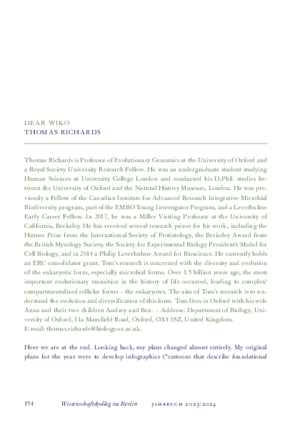Thomas Richards, D.Phil.
Professor of Evolutionary Genomics
Universität Oxford
Studied Human Sciences at University College London and Evolutionary Biology at the University of Oxford and the Natural History Museum, London
Arbeitsvorhaben
New Ways of Understanding Cell Evolution through Infographics
The infographic method brings together narratives, data, figures, and illustrations to convey complex themes in a manner accessible to a wide audience. Good infographics are like onions: you can look at the object or illustration in its entirety and understand it. Yet, they also have multiple layers that can be “peeled back” to convey details and data and to frame unresolved issues. They are a unique tool, providing an accessible narrative to complex stories.There are few more complex stories than how cells evolved; here, there are many hypotheses, little direct experimentation, and conflicting results. Such research integrates investigation from many disconnected academic fields, without which it is often difficult to see progress and unresolved questions. Summary and synthesis are therefore very important, as they allow people across different fields to understand what lies at the heart of unresolved issues and what further progress is needed. If communicated correctly, infographics also allow people not in the field – indeed not working in science at all – to see the progress of the discipline. New ways to communicate these narratives are needed. It is a long-term ambition of mine to develop a visual language to tell the story of cell evolution from the beginning of life to the emergence of complex, compartmentalised cellular forms. I will use my time at the Wissenschaftskolleg to put “pencil to paper” and begin this work.
Recommended Reading
Milner, David S., Victoria Attah, Emily Cook, Finlay Maguire, Fiona R. Savory, Mark Morrison, Carolin A. Müller, et al. (2019). “Environment-Dependent Fitness Gains Can Be Driven by Horizontal Gene Transfer of Transporter-Encoding Genes.” Proceedings of the National Academy of Sciences 116 (12): 5613–5622. https://doi.org/10.1073/pnas.1815994116.
Jenkins, Benjamin H., Finlay Maguire, Guy Leonard, Joshua D. Eaton, Steven West, Benjamin E. Housden, David S. Milner, and Thomas A. Richards (2021). “Emergent RNA–RNA Interactions Can Promote Stability in a Facultative Phototrophic Endosymbiosis.” Proceedings of the National Academy of Sciences 118 (38): e2108874118. https://doi.org/10.1073/pnas.2108874118.
Galindo, Luis Javier, David S. Milner, Suely Lopes Gomes, and Thomas A. Richards (2022). “A Light-Sensing System in the Common Ancestor of the Fungi.” Current Biology 32 (14): 3146–3153.e3. https://doi.org/10.1016/j.cub.2022.05.034.
Kolloquium, 05.12.2023
Understanding Compartmentalisation at the Origins of Life
Cells are the building block of all organisms. All cells are defined and encapsulated by membranes. I and many others would argue one of the most important changes during the evolution and diversification of life was compartmentalisation, a process determined by membranes. Every cell in your body has 100s of distinct compartments, nearly all of which are defined by membranes. Yet there has been almost no systematic or realistic study to understand how different membrane types perform basic functions. Our work focuses on trying to understand how compounds used for core cellular functions (‘metabolites’) can cross membranes a process that was important during the earliest phases of the evolution of life.
I will discuss our interdisciplinary experiments (Biology-Chemistry-Physics) which recreate simple cellular compartments (protocells) to study membrane permeability function. Using this approach, we have compared three different membrane chemistries that plausibly encapsulated the very earliest life-forms. We show that one particular membrane possesses all the permeability functions to support the evolution of metabolic functions. We then show that membrane permeability function of this same membrane type also selects for stereochemical (mirror image) ‘right-handed’ sugars and ‘left-handed’ amino acid chemistries. This membrane permeability function therefore explains the stereochemical bias hardwired into all of life on Earth (a long-standing mystery). This work provides unique insights into how life started.
Publikationen aus der Fellowbibliothek
Richards, Thomas (Lawrence, KS, 2025)
Richards, Thomas (Lawrence, KS, 2025)
Richards, Thomas (Lawrence, KS, 2024)
Reconstructing the last common ancestor of all eukaryotes
Richards, Thomas (London, 2022)
A light-sensing system in the common ancestor of the fungi
Richards, Thomas (Washington, DC, 2021)
Emergent RNA–RNA interactions can promote stability in a facultative phototrophic endosymbiosis
Richards, Thomas (Lawrence, KS, 2021)
Richards, Thomas (Washington, DC, 2019)
Richards, Thomas (2018)
PDZD8 is not the ‘functional ortholog’ of Mmm1, it is a paralog : [version 1; referees: 2 approved]
Richards, Thomas (London [u.a.], 2011)
Discovery of novel intermediate forms redefines the fungal tree of life
